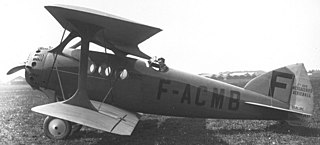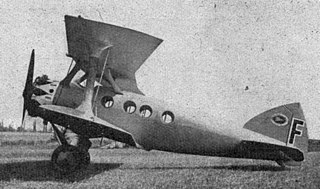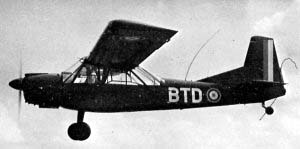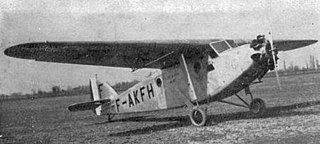| 90 | |
|---|---|
 | |
| Role | Civil utility aircraft [1] |
| National origin | France |
| Manufacturer | SPCA |
| First flight | 8 December 1932 [1] |
The SPCA 90 was a civil transport aircraft built in France in the early 1930s.
| 90 | |
|---|---|
 | |
| Role | Civil utility aircraft [1] |
| National origin | France |
| Manufacturer | SPCA |
| First flight | 8 December 1932 [1] |
The SPCA 90 was a civil transport aircraft built in France in the early 1930s.
The SPCA 90 was a high-wing monoplane of conventional layout with a thick-sectioned, cantilever wing. [1] [2] The cabin was fully enclosed, [1] and was large enough that the aircraft could be used as an air ambulance to carry two stretchers plus attendants. [2] [3] The fixed undercarriage consisted of divided main units and a tailskid. Only a single example was built (registration F-AKFJ), [1] which saw service in Morocco. [3]
In 1935, SPCA built an airliner version of the same design, designated 91T. [2] The cargo area was fitted out as a passenger cabin with seats for eight passengers, a baggage compartment, and a lavatory. [2] This was to be SPCA's last aircraft. [2]
Data from Parmentier 1998, except as noted
General characteristics
Performance

The Bleriot-SPAD S.33 was a small French airliner developed soon after World War I. The aircraft was a biplane of conventional configuration whose design owed much to the Blériot company's contemporary fighter designs such as the S.20. Four passengers could be accommodated in an enclosed cabin within the monocoque fuselage, and a fifth passenger could ride in the open cockpit beside the pilot. A great success, the S.33 dominated its field throughout the 1920s, initially on CMA's Paris-London route, and later on continental routes serviced by Franco-Roumaine.

The Blériot-SPAD S.56 was a family of French airliners developed in the 1920s as various refinements of the S.33 design. All S.56 versions shared two new features: the first was a newly designed, all-metal wing, replacing the wooden wing of earlier related designs and the second was a redesigned passenger cabin, replacing the S.33's four single seats in a row with two rows of double seats. A second access door was also added.

The Farman F.200 was a civil utility aircraft produced in France in the 1930s. Derived from the F.190, it featured a revised fuselage that did away with its predecessor's enclosed cabin. Instead, it was a parasol-wing monoplane with open cockpits in tandem for the pilot and one or two passengers. Intended primarily as a trainer, it was also marketed as being suitable as a photographic platform or a mail plane.

The Focke-Wulf A 17 Möwe was an airliner built in Germany in the late 1920s. It was a conventional high-wing cantilever monoplane with fixed tailwheel undercarriage. The aircraft provided fully enclosed seating for up to eight passengers and had a separate, fully enclosed flight deck for the two pilots. Most examples flew with Deutsche Luft Hansa, serving until around 1936. In the early 1930s, two A 17s were used for testing the Junkers Jumo 5 diesel engine.
The Hitachi TR.1 was a small airliner developed in Japan in 1938, produced in small numbers as the TR.2. It was a low-wing, cantilever monoplane with retractable tailwheel undercarriage and a fully enclosed cabin. The design strongly resembled the Airspeed Envoy that it was intended to replace in Japanese airline service. Testing of the TR.1 prototype commenced on 8 April 1938 at Haneda Airport, but it suffered a serious accident on 22 June due to a landing in which one of the main undercarriage units failed to extend.

The Nord 3400 Norbarbe was a French two-seat observation and casualty-evacuation aircraft built by Nord Aviation for the French Army Light Aviation.
The Hopfner HV-6/28 was a small airliner built in Austria in the late 1920s for Swiss use. Unrelated to Hopfner's other airliners of the period, the HV-6/28 was a conventional, high-wing, strut-braced monoplane with a fully enclosed cabin. The main units of the fixed tailskid undercarriage were divided. The single example built was flown by Aero St. Gallen between 1929 and 1931, and then scrapped.

The Lioré et Olivier LéO 21 was a 1920s French biplane airliner and later military transport based on the earlier LéO 20 night bomber.

The Sud-Est SE.200 Amphitrite was a flying boat airliner built in France in the late 1930s, originally developed as the Lioré et Olivier LeO H-49 before the nationalisation of the French aircraft industry. It was a large, six-engine design with a high-set cantilever monoplane wing, and twin tails. It was developed in response to a French air ministry specification of 1936 for a transatlantic airliner for Air France with a range of 6,000 km (3,700 mi) and capacity for 20 passengers and 500 kg of cargo. Designs were submitted by Latécoère, Lioré et Olivier and by Potez-CAMS as the Laté 631, LeO H.49 and the Potez-CAMS 161 respectively, and examples of all designs were approved for construction. A large mock-up, resting on simulated water, was displayed at the 1938 Salon de l'Aéronautique.

The Manshū MT-1 Hayabusa was an airliner produced by the Japanese Manchuria Airplane Manufacturing Company in Manchukuo in the late 1930s. It was a conventional, low-wing cantilever monoplane with fixed tailwheel undercarriage. The flight deck was fully enclosed and separate from the passenger cabin, which could seat six people. The type equipped Manchukuo National Airways.

The Bayerische Flugzeugwerke M 18, was an airliner, produced in Germany in the late 1920s.
The Messerschmitt M 24, otherwise known as the BFW M.24, was an airliner developed in Germany in the late 1920s as a further development in the series of designs produced by Messerschmitt, based on the M 18. Like the M 18 and its follow-on, the M 20, it was a high-wing cantilever monoplane with a fully enclosed cabin and fixed tailwheel undercarriage. It was slightly smaller than the M 20, seating only eight passengers instead of the ten that could be carried by the previous aircraft.

The Nieuport-Delage NiD 30 was a French airliner which entered service in 1920. It was a reverse-stagger biplane design with an enclosed cabin that seated four passengers and an open cockpit for the pilot. Provision was also made for a wireless transmitter, receiver, and operator. Seven examples were operated by Compagnie générale transaérienne on its Paris–London route on twice-daily return services.
The Nieuport-Delage NiD 38 was a touring aircraft built in small numbers in France in the early 1920s. It was a single-bay biplane of conventional design with an enclosed cabin for two passengers and an open cockpit for the pilot.

The SPCA 80 was a French transport monoplane designed by Société Provençale de Constructions Aéronautiques (SPCA) to meet a French government requirement for a single-engined colonial transport, specifically for police duties.

The Potez SEA VII, otherwise known simply as the Potez VII, was an early airliner developed in France shortly after the First World War.

The SABCA S.2 was an airliner built in Belgium in 1926.
The SITAR GY-100 Bagheera was a light aircraft designed and built in France in the late 1960s. Designed by Yves Gardan, it was a low-wing, cantilever monoplane of conventional layout with fixed, tricycle undercarriage. The fully enclosed cabin had seating for up to four people in 2+2 configuration. Construction was of metal throughout.

The SPCA 40T, also designated the SPCA VII, was a mailplane built in France in the late 1920s.

The SPCA Météore 63 was a flying boat built in France in the 1920s for use as an airliner. It was the first product of the SPCA company, founded by Laurent-Dominique Santoni when he left CAMS in 1925.